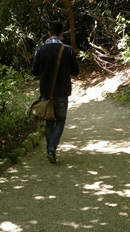
For some gardeners out there this time of year marks the great battle to collect every leaf that falls in their garden. As I have said before I am advocate of leaving the leaves to rest where they fall and then dumping them at the back of hedges and shrubs to break down out of sight.

However there are some gardeners who do the total opposite and are out with rakes and leaf-blowers to catch leaves before they even hits the ground. I have been on both extremes of the leaf debate. For work I have spent hours collecting leaves on a daily basis and then at home I am more relaxed. And speaking from experience, I don’t think there is a right or wrong way to do it. I always put it down to what works best for you and which option works for your type of garden. Some just do not look right with leaves everywhere, while in others it feeds into the organic naturalistic feel.
My one strict rule about leaves in the garden is, that once you collect them or tidy them up, you must use them for something and don’t simply fill your rubbish bin with them. Be it doing like I do with the majority of mine and let them break down naturally in flowerbeds or turning them in to leafmould, it is important to get the goodness out of them for the garden.
Leafmould is a great thing to make for the garden as it is really like liquid gold for pots and containers. It also makes for a great material to add into planting holes to give new plants a boost in the garden. The best part of leafmould is that it requires very little work to make, apart from the gathering of the leaves.

Once you have collected your leaves you want to fill black bin liners with them. If the leaves are very dry when you are filling the bags, moisten them slightly to help with the break down. Then loosely tie the top of the bag and poke some holes in the side of the bag.
Then you simply leave the bags for around a year and a half to two years to get a very fine leafmould. It can be used the following year for the bottom of planting holes, but from experience you want it to be fully broken down for pots and containers.
Of course if you don’t have trees in your own garden there are plenty of places to get leaves to use. From a friend or neighbors garden, public parks or from the street. It is important though to not uses ones from very busy streets or main roads where the leaves may be contaminated from salts and chemicals spread on the roads in the lead up to winter.

My Name is David Corscadden and I have just finished my degree in horticulture from UCD. I have a keen interest in wildlife friendly gardens or as I like to call them “Wild Gardens”. I have in the last year taken a u-turn in what I thought I would do after college. I have moved more in to the literature side of horticulture and plan to do a masters in journalism next year.
Source: Beyond The Wild Garden – Turning Leaves In To Gold – David Corscadden






